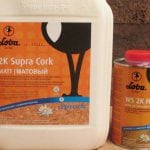Cork decorative coatings are now widely used in wall and floor cladding indoors. This is a natural finishing material made from bark of balsa wood. It is chosen not only because of unique decorative features, but, first of all, because of strength, durability, environmental friendliness, ease of care, practicality, heat, sound insulation, antistatic. And all thanks to the porous structure of the material. In order for the coating to “live” longer without restoration, it is recommended to additionally use a special varnish for cork coatings.
The protective coating allows you to protect the cork material from moisture, dirt, increase strength, protect it from damage. This is especially required if the cork-based profile is used as a floor covering.
to contents ↑Varnish selection
The market of modern paint and varnish products offers a wide selection of materials for various needs. There are universal compounds that are easily applicable for processing materials of different quality. Many products are offered for a certain type of decorative coating.
For cork flooring on a glue and vinyl basis, polyurethane varnish is offered. Its primary task is to strengthen the moisture-resistant qualities of the coating. The applied substance penetrates deep into the base, filling, but not burdening its porous structure. After drying, an elastic, waterproof film is formed, strong and durable.
The chemical composition of polyurethane mixtures can be one- and two-component. The second, due to the presence of hardeners, dry on the cork surface much faster (in just two hours). For greater reliability, it is recommended to coat the floor with varnish in several layers.
After complete drying, the cork will acquire complete tightness, perfect evenness and absolute inertness to moisture, temperature changes and other “vicissitudes of fate”.
When choosing a varnish in composition, you should pay attention to the type of solvent. So for indoor use, water-based parquet varnish is needed. It is not toxic, not combustible. Also:
- has high final strength and elasticity;
- provides a high level of wear resistance of surfaces to chemicals;
- not afraid of low temperatures;
- does not slip;
- resistant to abrasion and feasible mechanical stress;
- Inertness to ultraviolet light makes it possible to varnish a cork without fear of burnout.
Applying varnish
To open the cork with varnish is possible only after the parquet glue has completely dried. Manufacturers of paints and varnishes and specialists-SUVs tirelessly repeat this, following the technical instructions in the work. It is most convenient to apply with a velor roller. It is recommended to carry out surface treatment in at least three layers.
Paint and varnish products are usually sold in a ready-to-use solution. Before starting the painting, the substance should be thoroughly mixed until homogeneous. Too viscous solution can be diluted a little.As a diluent, the substances that form the basis of the mixture (water or organic solvents) are used, but not more than 10% of the total packaging volume.
For better adhesion, an additional primer is used for parquet products made from natural materials. If the cork profile does not have factory impregnation, then feel free to use the selected varnish.
If the decorative coating was applied earlier in the factory, a preliminary compatibility test should be performed.
Intermediate grinding is also recommended here. This will provide a matte, optically more uniform surface. If the finishing layer is applied within 24 hours after the previous layers, then intermediate sanding is not required, more than a day is necessary. The varnish is applied to a clean, polished surface, so dust and dirt need to be collected with a vacuum cleaner or a dry cloth.

In atmospheric conditions - temperature +20 degrees, air humidity 65% - the varnish will dry within 4 hours. For multi-layer treatment of cork with varnish, a period of at least 24 hours must be maintained before putting the room into operation. Final polymerization will occur in 5 days. Up to this point, it is not recommended to lay carpets and walkways, as well as conduct wet floor cleaning.
to contents ↑Coating care
In the future, care for cork floors is very simple.
- Vacuum cleaning of surfaces.
- Washing with non-aggressive household chemicals.
- An exception to everyday life when cleaning cork floors of scrapers, equipment with an abrasive, brushes and brooms with hard bristles.
- Cosmetic renewal of the protective layer. After a few years, the polyurethane varnish can be applied repeatedly, but it is recommended to remove the old decorative layer.
- Maintenance of certain climatic conditions in the room: temperature - not higher than +25 degrees; moderate humidity (50-65%).
- Sharp and thin legs of cabinet and upholstered furniture (especially heavy) should be additionally equipped with felt overlays.
- The use of soft carpets over cork parquet products.
Cork flooring is always an extraordinary beauty, originality and uniqueness of decoration. Walking on this floor is a pleasure, because it is soft and warm. The use of natural materials in the decoration of residential premises is always beneficial: not only from an economic point of view, but also due to comfortable, safe living.







